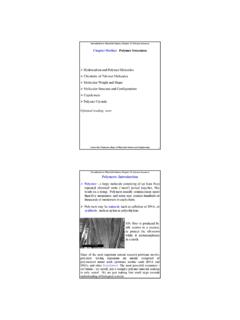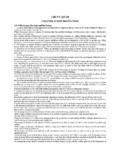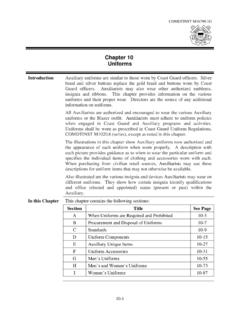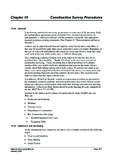Transcription of Chapter 15: Clearance
1 15 1 Chapter 15: ClearanceHow To Do IT ..15 4I. Introduction ..15 7A. Regulations Pertaining to Clearance ..15 7B. Purpose and Scope of 7C. De Minimis Area Minimal Area of Paint Disturbance when Clearance Is Not Required ..15 9II. Qualifications for Clearance Examiners ..15 10A. Regulatory Qualifications ..15 10B. Conflicts of Interest ..15 10 III. Time Between Completion of Cleanup and Clearance ..15 11IV. The Clearance Area, and Sampling of Units, Rooms, or Areas ..15 12A. Determining the Clearance Area and Schedule ..15 121. Interior Clearance Areas ..15 122. Clearance Area Following Exterior Work ..15 133. Information for Clearance Area Determination ..15 14B. Sampling of Rooms, Units or Areas ..15 151. Sampling Rooms within a Unit ..15 152. Sampling Units within a Multi-family Property ..15 16V. Visual Assessment ..15 17A. Visual Assessment for Deteriorated Paint ..15 17B. Visual Assessment for Settled Dust and Debris ..15 191.
2 Interior ..15 192. Exterior ..15 20C. Completion of the Visual Assessment Form ..15 20VI. Clearance Dust Sampling ..15 20A. Sampling Methods ..15 201. Wipe Sampling ..15 202. Composite Sampling ..15 213. On-site Dust Testing ..15 24B. Clearance Dust Sampling and Sealant Application ..15 25C. Location and Number of Clearance Dust Samples ..15 251. Clearance Categories ..15 252. Selection of Rooms ..15 293. Selection of Locations Within Rooms ..15 304. Sampling Outside the Containment Area ..15 325. Worksite-Only Sampling ..15 3215 2 Chapter 15: CLEARANCE6. Composite Sampling: An Example ..15 33D. Securing the Clearance Area ..15 33 VII. Clearance Soil Sampling (optional) ..15 34A. Considerations for Sampling Soil Before the work ..15 34B. Considerations for Sampling Soil After the work ..15 34C. Multi-family Housing Properties with more than one Building ..15 35 VIII. Determining Specified Hazard Control work was Done (optional).
3 15 36A. Paint Removal and Repainting ..15 37B. Building Component Removal and Replacement ..15 38C. Enclosures ..15 38D. Encapsulants ..15 38E. Soil Treatments ..15 38F. Interim Controls ..15 38IX. Interpretation of Clearance Results, Recleaning, and Resampling ..15 39A. Visual Assessment Results ..15 39B. Dust Sampling Results ..15 39C. Recleaning and Resampling ..15 391. Single-Surface Clearance Sampling ..15 392. Composite Clearance Sampling ..15 40X. Report Preparation ..15 42A. Summary Report ..15 42B. Regulatory Report Requirements ..15 43XI. Recordkeeping ..15 44A. Recordkeeping Responsibilities ..15 44B. Record Content ..15 44C. Length of Retention ..15 44 REFERENCES ..15 55 FoRMS Form Visual Assessment Lead Hazard Clearance Examination..15 45 Form Field Sampling Form for Dust Lead Hazard Clearance Examination (single-surface sampling)..15 46 Form Lead Hazard Clearance Report Completed Example ..15 47 Form Clearance Report Review Worksheet.
4 15 53 Form Clearance Report Review Worksheet Completed Example ..15 5415 3 Chapter 15: CLEARANCETABLEST able Minimum Number and Location of Dust Samples ..15 27 Table Clearance Dust Standards (Single-Surface Wipe Samples) ..15 39 Table Clearance Dust Standards (Composite Wipe Samples) ..15 41 Table Hypothetical Example of Single-Surface Clearance Dust Sampling Data..15 41 Table Hypothetical Example of Composite Clearance Dust Sampling Data..15 41 FIgURES Figure Windows sealed to prevent dust migration ..15 13 Figure Visible paint chips and debris in soil ..15 14 Figure Visible dust Indicates recleaning is needed ..15 19 Figure Tracking of dust that may contain lead ..15 19 Figure Indications that children are present ..15 26 Figure A floor that may be tested ..15 30 Figure A windowsill and trough that may be tested ..15 30 Figure Window locations for dust sampling ..15 31 Figure Soil debris ..15 34 Figure Surfaces that may have been paint stripped.
5 15 3715 4 Chapter 15: CLEARANCEC hapter 15: ClearanceHow To Do It1. Qualifications for Clearance examiners. The owner, funding agency, certified abatement contractor, or certified renovation contractor should select the Clearance examiner, preferably before lead-based paint hazard control work begins. Clearance on all projects involving abatement (as defined by EPA) must be done by a certified risk assessor or a certified lead-based paint inspector. Check with EPA regarding qualifications for clear-ance of non-abatement activities. For properties covered by HUD s Lead Safe Housing Rule, and those of some State regulations, clear-ance of non-abatement work may be performed by a certified risk assessor or lead-based paint inspec-tor, or by a certified sampling technician, if the sampling technician is working in single family units or a multi-family dwelling unit and the associated common areas. If the Clearance requires development of a random sampling plan, a certified inspector or risk assessor must develop the plan and supervise the sampling technician in its use.
6 Not all States or localities have certified sampling technicians, and some require that non-abatement Clearance be conducted only by certified risk assessors or inspectors. For clearing projects covered by the EPA s Renovation, Repair, and Painting (RRP) rule, a certified risk assessor, certified lead-based paint inspector, or certified dust sampling technician can perform clear-ance. (See below regarding clearing multi-family housing projects.) To eliminate conflicts of interest, these Guidelines recommend the use of a Clearance examiner who is completely independent of the contractor who performs the work. HUD s Lead Safe Housing Rule requires such independence for Clearance of most work in HUD-assisted target housing. (See Appendix 6 for details.)2. Determine the Clearance area. Obtain information from the client regarding the nature and location of the work and the dust containment (if any); for an abatement, project, validate or obtain a copy of the abatement site plan.
7 Then determine the Clearance area ( , the dwelling units, common areas, rooms, and/or exterior areas that are subject to the Clearance examination). Clearance examiner should explain all aspects of the examination to the Preclearance worksite inspection on behalf of the client (optional): As part of deciding, once the lead hazard control, renovation or maintenance work has been completed, the cleanup is done, and the floors are sealed (if necessary), whether to call for the Clearance examiner, the client, contractor or maintenance supervisor may conduct a visual assessment of the Clearance area to determine if there is any deteriorated paint, visible settled dust, paint chips, or paint-related debris in the interior or around the exterior of the building(s). If conducted, this preliminary visual assessment should be conducted in all the dwelling units and rooms in the Clearance area, except that it may be conducted in a sample of dwelling units and related common areas in a multi-family property.
8 After the visual assessment is passed, it may also be useful to take dust samples for quick onsite analysis before calling the Clearance wait one hour for dust to settle. Before beginning the Clearance examination, wait at least 1 hour after the hazard control, renovation, or maintenance work is finished, the cleanup is done, and the floors are sealed (if necessary) to allow any leaded-dust particles to settle. Do not enter the work area during that 5 Chapter 15: CLEARANCE5. Conduct visual assessment. Conduct a visual assessment (called a visual inspection by EPA) of the Clearance area to determine if there is any deteriorated paint, visible settled dust, paint chips, or paint-related debris in the interior or around the exterior of the building(s). The visual assessment should be conducted in all the dwelling units and rooms in the Clearance area, except that it may be conducted in a sample of dwelling units and related common areas in a multi-family property (see Chapter 7 for unit/common area sampling methods).
9 6. Complete visual assessment form. Complete a visual assessment form for Clearance , such as Form in this Chapter . If any unexplained deteriorated paint or visible dust, paint chips, or paint-related debris are found, inform the client and request that hazard controls and/or cleanup be completed, as necessary, so that dust sampling can proceed. See 24 CFR (c) for more details of what is required under the Lead Safe Housing Rule for HUD-assisted housing (see Appendix 6).7. Conduct dust sampling. After the Clearance area has passed visual assessment, conduct Clearance dust-wipe sampling of floors, interior window sills, and window troughs using the protocol in this Chapter and Appendix , or ASTM Standard E 1728 ( ).8. Complete a dust sampling form for Clearance , such as Form in this Submit dust samples for analysis for lead to a laboratory recognized for analysis of lead in dust by the EPA s National Lead Laboratory Accreditation Program (NLLAP).10. Interpret the laboratory results by comparing them to the applicable standards.
10 In most jurisdictions, these will be the EPA Clearance standards described in this Chapter . If State or local standards differ from the EPA standards and the work being cleared is subject to HUD or EPA lead-based paint regulations, the most protective standards (EPA, State, or local) apply. If the work being cleared is not subject to HUD or EPA regulations, use State or local standards, if they exist. If State or local standards do not exist, use the EPA Notify the client of the results of laboratory tests as soon as they are received, so residents can reoccupy the Clearance area as soon as possible if Clearance is achieved, or recleaning can be started quickly if dust-lead levels exceed applicable If Clearance is achieved, go to step 15. If not, go to follow steps 13 and Repeat cleaning if Clearance is not achieved. If dust-lead levels are equal to or greater than the applicable standards, the client should order repeated cleaning. Clean all surfaces that the failing samples represent.














